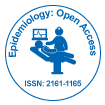Planning and Response to Communicable Disease on US Domestic Air Flights
Received Date: Feb 12, 2016 / Accepted Date: Feb 22, 2016 / Published Date: Feb 28, 2016
Abstract
Globalization along with the ongoing spread of novel infectious diseases including influenza, coronavirus, and Ebola has spurred growing interest and significant research on the impact of commercial air travel as a factor contributing to the spread of disease from one geographic location to another. Despite this, there has been little to no research on the appropriate response to this public health challenge and the coordination of response capabilities across key responders. We conducted a tabletop exercise to explore a scenario that simulated a U.S. domestic commercial flight transporting a passenger infected with probable MERS-CoV. Participants included a broad range of stakeholders in a medium-sized Mid-western U.S. city. The tabletop exercise revealed gaps in public health preparedness among response partners that require improved collaboration among public health, airport operations and airline personnel, and fire and emergency management services.
Keywords: Communicable disease; Domestic air flights; Ebola; Influenza
Citation: Dausey DJ, Biedrzycki PA, Cook T, Teufel T, Vendeville M, et al. (2016) Planning and Response to Communicable Disease on US Domestic Air Flights. Epidemiology (Sunnyvale) 6:225. Doi: 10.4172/2161-1165.1000225
Copyright: © 2016 Dausey DJ, et al. This is an open-access article distributed under the terms of the Creative Commons Attribution License, which permits unrestricted use, distribution, and reproduction in any medium, provided the original author and source are credited.
Select your language of interest to view the total content in your interested language
Share This Article
Recommended Journals
Open Access Journals
Article Tools
Article Usage
- Total views: 12348
- [From(publication date): 4-2016 - Dec 06, 2025]
- Breakdown by view type
- HTML page views: 11314
- PDF downloads: 1034
